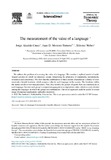The measurement of the value of a language
Fecha
2022Versión
Acceso abierto / Sarbide irekia
Tipo
Artículo / Artikulua
Versión
Versión publicada / Argitaratu den bertsioa
Identificador del proyecto
Impacto
|
|
10.1016/j.jet.2022.105468
Resumen
We address the problem of assessing the value of a language. We consider a stylized model of multilingual societies in which we introduce axioms formalizing the principles of impartiality, monotonicity, invariance and consistency. We show that the combination of these axioms characterizes a family of communicative benefit functions which assign a value to each language in the society. The functio ...
[++]
We address the problem of assessing the value of a language. We consider a stylized model of multilingual societies in which we introduce axioms formalizing the principles of impartiality, monotonicity, invariance and consistency. We show that the combination of these axioms characterizes a family of communicative benefit functions which assign a value to each language in the society. The functions within the family involve a two-step procedure. First, they identify the groups of agents that can communicate in each language. Second, each group is assigned an aggregate (size-dependent) value, which is evenly divided among the languages in which the group can communicate. Our novel approach could be useful in a wide range of empirical applications and policy decisions. [--]
Materias
Value of a language,
Communicative benefits,
Measure,
Axioms,
Characterization
Editor
Elsevier
Publicado en
Journal of Economic Theory 203 (2022) 105468
Departamento
Universidad Pública de Navarra. Departamento de Economía /
Nafarroako Unibertsitate Publikoa. Ekonomia Saila /
Universidad Pública de Navarra/Nafarroako Unibertsitate Publikoa. Institute for Advanced Research in Business and Economics - INARBE
Versión del editor
Entidades Financiadoras
The first author acknowledges the financial support from the Spanish Government through grant PGC2018-093542-B-I00 funded by MCIN/AEI/10.13039/501100011033 and by 'ERDF A way of making Europe'. The second author acknowledges the Spanish Government through grant PID2020-115011GB-I00, funded by MCIN/AEI/10.13039/501100011033. Funding for publishing: Universidad Pablo de Olavide/CBUA.







